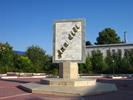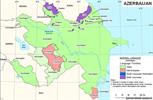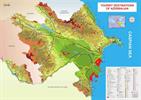Azerbaijani language is the state official language of Azerbaijan and the mean of linguistic communication of the 9 million population of the country (2010).
Besides, Azerbaijani is also spoken by 20 million Azerbaijanis residing in the Islamic Republic of Iran. Several millions of Azerbaijanis reside in Russia, USA, Turkey and Western Europe. Regardless of their current country of residence, Azerbaijanis still can understand each other easily. There are over 30 million speakers of Azerbaijani at present.
Genealogically, Azerbaijani language belongs to the Turkic group of languages and, together with closely associated Turkish, Turkmen and Gagauz languages, forms the southwestern group of Turkic languages.
From the traditional-morphological and typological point of view, the Azerbaijani language belongs to the group of agglutinative languages. Unlike inflexional languages, all words of Azerbaijani as well as other agglutinative languages are lexically and grammatically independent units: grammatical meanings and grammatical relations are built by monosemantic inflexions which follow the stem and the root of a word.
The Turks who make up the ethnic foundation of the Azerbaijani people appeared in the territory of the present Azerbaijan long before our century and in the early first millennium along with other numerous tribes were the ancient residents of these lands. The appearance of a nation of Turkish origin and speaking Azerbaijani language and the transformation of this language to a means of communication was a long process, covering several centuries.
With the increase in the number of Turkish tribes as well as their economic, political and cultural influence the language was enriched and thus ethnic groups, that manage to preserve their ethnic and anthropological peculiarities even nowadays, united into a nation with a unique culture and language.
The Azerbaijani language is one of the languages that had passed a long path of development. Regarding the epos Kitabi Dede Gorgut as the unwritten pattern of our literature, the age of the language serving the people as a means of communication can exceed 1300 years. Some materials point out that the history of written literary language of Azerbaijan commences with 13th century.
Through the 800 years of its development, the Azerbaijani literary languages had passed through two main periods. The old period covers the 13th up to 18th century, while that one referred to as a new one started since 18th century and continues up to present times.
The first stage is notable for a vast area of the usage of the Azerbaijani language. The palace and military Azerbaijani language used by Djelairids, Qaraqoyunlus, Aggoyunlus and Sefevi states was the literary language of the Asia Minor. The Azerbaijani language of this period differed from that of the new period not by its extra linguistic and linguistic properties.
The vocabulary of the language of the first period was distinguished by the predominance of words of Arabic and Persian origin. The styles of the language of that period, especially the predominant genre of poetry and various stylistic devices caused the inflow of a great number of loan words in the literary Azerbaijani language. The establishment of schools of realism and realistic literary method and the formation of the latter as a leading creative caused disappearance of the loan words that did not join the vocabulary of the language.
Moreover, the words of the Azerbaijani language, derived from the Osmanly language (shimdi (now), shoyle (such), shu (this, that), kendi (oneself) abandoned the language in the new period. That resulted from the full completion of the process of Turkish languages differentiation.
The language of two periods differs by its phonetics. Thus, the new period was marked by the stabilization of the system of phonemes in the literary Azerbaijani language. The interchange of vowels o//a, and consonants//x peculiar of the first period resulted in winning of the first (o and h) in the second period.
The similar processes occurred in grammar. The interchange of inflexes of accusative case -yi, -yı, -yu, -yü///-ni, -nı, -nu, -nü typical of the literary language of the first period disappeared in the second period.The inflex of the future tense of the verb -isər was replaced by the inflex -acaq//-əcək.
In the old Azerbaijani language word combinations mainly built on Arabia and Persian syntactic models: fəsli-gül (gül fəsli, blossoming season), tərki-təriqi-eşq (eşq təriqinin (yolunun) tərki, abandonment of the path of love), etc. In such constructions the attribute preceded the determinate. The second period is characterized by quite opposite process: the determiner is always used before the defined.
In the first period the complex composite sentences with a subordinate clause, placed within the principal one, while in the second period such kinds of sentences were replaced by participle constructions.
Both periods are themselves divided into a number of stages
The first period of the development of Azerbaijani language passed two stages:
- Formation of the literary language(13th-14th cc)
- Flourish of the classical language of poetry (15th-18th cc)
- The second period covers three stages:
- Nationalization of the literary language (18th century)
- Establishment and development of the national language (19th-early 20th cc)
- Present-day stage (20th-early 21st cc)
New period. The second period was marked for the flourishing of the Azerbaijani language especially within the stage of the establishment and development of the national language. Along with poems the language was used in creating literary works, publishing newspapers and magazines and even in a number of official documents and scientific research. At that time foreigners, Russian and Germans displayed a great interest to this language and some of them started learning it. These were Russian poets Lermontov, Bestujev-Marlinski, German oriental scientist Bodonshtedt. The latter learned Azerbaijani language from the Azeri poet Mirza Shafi, translated his poems to German and published them in a separate book. Though the dictionaries of the old Azerbaijani language were compiled and grammatical researches were conducted in the Middle ages, the scientific works and text-books began to appear in the 19th century. Most famous of them is the work "General grammar of Turkish-Tatar language" by Mirza Kazymbey. The text-books by M.Vezirov, L.Buqagov, Q. Makarov, M.L.Mamedov, S.M. Ganiyev related to the Azerbaijani language were also written in Russian. L.Budaqov also compiled a dictionary in two volumes (Сравнителный словар турецко-татарских языков). The valuable work "Fənni-sərfi-türki" ("The grammar of Azerbaijani language") by M.Ashrafly is also written in Azerbaijani.
The 20th century was the flowering as well as the problematic period in the development of Azerbaijani language. At that very time Azerbaijani language faced a great problem. Since the beginning of the century three trends emerged in the literary Azerbaijani language. These are mainly related to the language of literary creations and press.
1. The first trend attempted to bring the literary language as closer to the colloquial language as possible. This is proven by creative activity of Molla Nasreddin magazine and its collaborators (Dj. Mamedguluzade, A.Haqverdiyev and others). These creations do not differentiate between literary language and colloquial language and dialects. Such language is more understandable to ordinary people.
2. The trend mainly focusing on the establishment of a literary language resting on the traditions of oil Azerbaijani language and the language of Osmanly Turks. This trend was mainly adhered by a number of magazines and newspapers as Fyuzat and Heyat and mainly by their collaborators (A.Guseynzade, Sabribeyzade and others). Yet, the people do not find it easy to understand such a language. This language almost did not differ from the old Turkish language.
3. The trend, which propagandized the establishment of a literary language based on the norms of a literary language and understandable by everyone. This language was one not influenced by any dialect. It was created by such writers and poets as A.Shaig, Dj.Djabbarly, S.Guseyn, A.Sahhat. This situation lasted from early century till the 1930th.
The third stage of the development of Azerbaijani language was marked by the attachment of the status of the state language to it.
The Constitution of independent Azerbaijan, accepted through national voting confirmed Azerbaijani language as the state language of the country:
Article 21, The State Language.
The state language of the Azerbaijan Republic is Azerbaijani language. Azerbaijan provides for the development of the Azerbaijani Language.
Heydar Aliyev, who always attached a great importance to his native language and had a profound knowledge of it, considering the situation, created at the turn of the new period of the state language development, signed a decree "On perfection of measures for the use of the state language" on June 18, 2001.
The said decree, along with reflecting the achievements of the language through the history of its development also determined existing problems of the language and pointed out the ways of their resolution.
Some of these ways have already implemented successfully. The decree of President of the Azerbaijan Republic Ilham Aliyev signed on January 12, 2004 "On the publishing of mass media in Latin alphabet in Azerbaijani language will, undoubtedly, settle all the problems connected with the alphabet.
Each of the three stages of the second period had its own peculiarities. As mentioned above, at present, the Azerbaijani language is used not only in Azerbaijan but also in Iran and Iraq. Folklore creations testify that the languages used by Azerbaijanis residing in these countries, do not differ much. However, the difference lies in literary languages and it's mainly reflected in printed literary creative works, newspapers and magazines, radio and TV programs. The difference is caused by historical and social reasons.
A war between Iran and Russia resulted in signing two agreements Gulustan (1818), Turkmenchay (1827) which divided Azerbaijan in two parts. Thus, for nearly 200 years, two parts of one nation live separately and in quite different conditions and environment. Both Iran and Russia did not admit the relations between the two parts of the nation. Though Azerbaijan established definite relations after gaining independence, yet the difference is too deep especially in languages.
Like other spheres, the difference lies also in literary language. The language of independent Azerbaijan still contains traces of Russian language, while the language of South Azerbaijan is influenced by the Persian language. At present, literary language of North and South Azerbaijan still differ in vocabulary, phonetics and in some way grammar (especially, in syntax)
These differences are caused by some extralinguistic factors. Though Azerbaijan has been the part of Russia till 1991, the Azerbaijani language has been taught in secondary schools, institutes and universities for 76 years. The researches in the sphere of Azerbaijani language, its history and dialects were conducted intensively and hundreds and even more creative works were devoted to this topic in Azerbaijani language. It's possible to say that the most famous literary creations of all the nations beginning from the literature and philosophy of Ancient Greece up to present-day literary and scientific creations have been translated in Azerbaijani language. At present the text-books on all subjects (mathematics, physics, chemistry, medicine, etc) are written in Azeri or translated from other languages.
Except for one or two newspapers and magazines, Azerbaijani language almost is not used in South Azerbaijan.
The 3-4 centuries gap between Azerbaijanis and Iraq Azerbaijanis, remoteness of areas and disconnection caused the literary language to step on quite different paths. The literary language of Iraq Azerbaijanis is much influenced by the language of the present-day Turks.
In recent years the formation and development of language of those residing in different countries is much influenced by the attempt to bring it closer to the literary language of Azerbaijan and the process is hoped to be successful.
Modern Azerbaijani Language as one of the Turkish languages has a specific grammatical and phonetic properties. Due to the existence of the law of harmony in this language, front vowels (i,ü,e,ə,ö) and back vowels (I, u, a, o), differing by the place of formation can not be used within the same word. (except for words like işıq, ildırım beginning with vowel i): at the same time the front vowels can not be used with velar consonants (k,q,ğ,x), while back vowels can nor follow dorsal consonants (g, k).
The Azerbaijani language consists of 15 vowel and 25 consonant phonemes. These 40 phonemes are marked with 32 letters of the Azerbaijani alphabet.
There are 9 short (i,ü,e,ö,ə,a,o,u,ı) and 6 long (i:,e:,ö:,ə:, a:,u:) vowels in Azerbaijani language. Long vowels are not typical of this language and are mainly found in loan words.
As a rule, phonetic accent falls on a last syllable. Phonemic accent does not depend on the lexical meaning of a word: 'alma (an apple)-alma' (don't take).
The vowel ı and consonant ğ are not used at the beginning of a word in Azerbaijani language.
The morphological system of Azerbaijani language includes notional parts of speech (nouns, adjectives, numerals, pronouns, adverbs, verbs) and secondary (postpositions, conjunction, particles, modal words, interjection).
Nouns are characterized by the categories of number, possession, case and can be used as a predicate. These categories are typical of other substantiated parts of speech.
The category of case consists of 6 cases (nominative, possessive, dative, accusative, ablative, prepositional). The verb has five tenses (the past indefinite tense, past declarative tense, present tense, future suppositional tense, future complete tense) and 6 forms of mood (order, wish, condition, necessity, importance, predicate).
Depending on the relations between subject, object and predicate, verbs can be used in five grammatical voices (active, passive, reflexive, causative, interaction).
According to the syntactical rules of Azerbaijani language, subject is used at the beginning of a sentence, predicate at the end, while attribute precedes the word it modifies.
In Azerbaijani language words are forming by using morphological methods: (dəmirçi (a blacksmith), üzümçü (Vine-grower), təbliğatçı (propagandist); dəmirçilik (the profession of blacksmith), üzümçülük (vine-growing), təbliğatçılıq (propaganda); dolça (a can), qazança(a pan) otluq(grassland), meşəlik (woodland) qaldırıcı (lifting), endirici (drawoff) ; sevinc (joy), gülünc (smile); yavaşca (slowly, carefully), indicə (just) and syntactical ones (otbiçən (hay-maker), vaxtamuzd (time work), boyunbağı (necklace), gündoğan (east), sarıköynək (oriole), əlidolu (with the hands full (of), adlı-sanlı (celebrated, famous), qırxayaq (centipede), beşaçılan (rifle having five charges), etc).
To date Azerbaijan uses the Azerbaijani alphabet, established on the basis of Latin letters.
Depending on the areas of usage of literary Azerbaijani language, it combines four main styles: official style, publicistic style, belles-letters and the style of scientific prose. To date all the styles are on highly developed.
Great changes occurring in political, scientific, cultural life of the country caused the rapid increase of terms in the vocabulary of Azerbaijani language. This process is observed in all styles, especially in official and scientific styles and in some way in the publicistic style.
The dialects of the Azerbaijani language consist of four groups: 1) eastern group (Baku, Quba, Shamakhi, Lenkeran , Mugham dialects; 2) western group (Ganja, Qazakh, Karabakh and Ayrym dialects); 3) northern group (Sheki, Zagatala-Qakh dialects); 4) southern group (Nakhichevan, Ordubad dialects).
|
Important information on visa: If you're going to vizit Azerbaijan check the latest information of visa regime here >>>. Regularly updated data, helpful advice and expert guidance. If you have any questions, please do not hesitate to contact us. |










